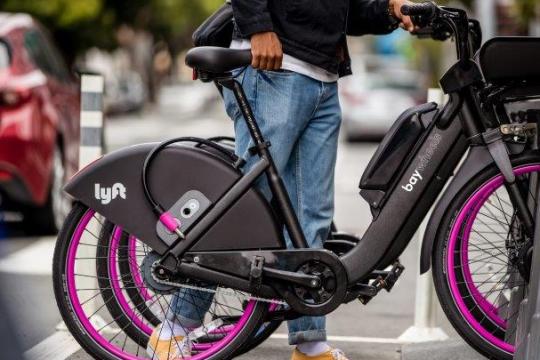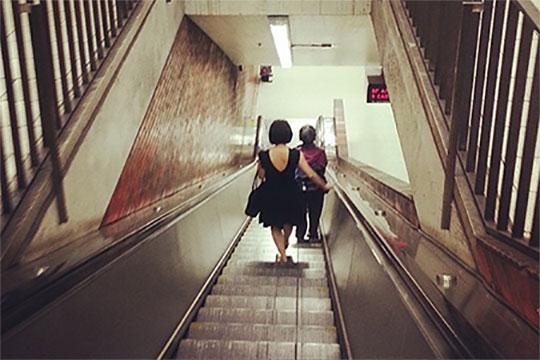Bicyclists on public roadways have all the same rights and responsibilities as automobile drivers, and are subject to the same state laws and local ordinances. For everyone's safety, observe these bicycling rules and safety tips.
Bicycle Access
Be sure to take a look at which Bridges and Tunnels have bicycle (and pedestrian) access.
Safety Tips for Riding Your Bike in Traffic
Wear a helmet.
![]()
Bicyclists and bicycle passengers under 18 years old are required to wear helmets meeting specified standards (ANSI Z 90.4 Bicycle Helmet Standard, SNELL or The American Society for Testing Materials ASTM F-1447 Standard) that are conspicuously labeled with those standards. This also applies to a passenger in a restraining seat attached to the bicycle or in a trailer towed by the bicycle.
Always ride with traffic.
![]()
Motorists are not looking for bicyclists riding on the wrong side of the road. Also, you can endanger an oncoming bicyclist.
Observe stop signs, signals and basic right-of-way-rules.
![]()
Bicycle riders on public streets have the same rights and responsibilities as automobile drivers. Cyclists are part of the normal traffic flow and are entitled to share the road with other drivers. Like drivers, bicyclists must yield to pedestrians.
Bicyclists should normally ride as near to the right curb or edge of the roadway as practical. Never ride on the sidewalk, unless it is specifically marked as a bike route.
Keep clear of the door zone.
![]()
Try to ride a door’s width away from parked cars. If you have to ride in the door zone, ride very slowly. You have the right to ride in a traffic lane if it is too narrow to share with a car.
Use hand signals.
![]()
Hand signals tell motorists what you intend to do. Signaling is a matter of law, of courtesy, and of self-protection.
All required signals are given as follows:
- Left turn: left hand and arm extended horizontally beyond the side of the bicycle;
- Right turn: two signaling methods exist, including left hand and arm extended upward beyond the side of the bicycle, or right hand and arm extended horizontally. While signaling with the right hand is more widely understood, braking may be more difficult with this method.
- Stop or sudden decrease of speed: left hand and arm extended downward beyond the side of the bicycle.
Keep both hands ready to brake.
![]()
You may not stop in time if you brake one-handed. Allow extra distance for stopping in the rain and heavy fog, since brakes are less efficient when wet.
If you are a bicyclist carrying a package or bundle, you must keep at least one hand on the handlebars.
Ride a well equipped bike.
![]()
Be sure your bike is adjusted to fit you properly. For safety and efficiency, outfit it with a bell, rear-view mirror, rack or basket, lights and reflector. Carry a water bottle, bike pump and patch kit. Wear a helmet. Keep your bike in good working order.California law requires all bicyclists and bicycle passengers under 18 to wear helmets that meet specific safety standards. A passenger is allowed on a bicycle only on a separate attached seat. If the passenger is 4 years old or younger or weighs 40 pounds or less, the seat must adequately retain the passenger in place and protect him/her from the bicycle's moving parts.
Bicycling at night.
![]()
Bicycles operated during darkness are required to be equipped with the following:
- A white light that illuminates the roadway and is visible from a distance of 300 feet to the front and sides of the bicycle. (A white light attached to the bicyclist that is visible from 300 feet to the front and sides of the bicycle may be used in place of a light attached to the bicycle.)
- A red reflector mounted on the rear of the bicycle and visible from 500 feet to the rear of the bicycl
- A white or yellow reflector mounted on each pedal visible 200 feet to the front and rear of the bicycle, a white or yellow reflector on each side forward of the center of the bicycle and a white or red reflector on each side to the rear of the center of the bicycle. Bicycles equipped with reflectorized tires on the front and rear need not be equipped with side reflectors. All reflectors and reflectorized tires must meet DMV requirements.
Don't weave between parked cars.
![]()
Don't ride out to the curb between parked cars, unless they are far apart. Motorists may not see you when you try to move back into traffic.
Follow lane markings.
![]()
Cyclists make left and right turns in the same way that drivers do, using the same turn lanes. A cyclist turning left should use a left-turn lane. A cyclist traveling straight ahead should use a through traffic lane rather than ride next to the curb and block traffic making right turns. Don't turn left from the right lane.
Choose the best way to turn left.
![]()
There are two ways to make a left turn:
-
Like an auto. Signal, move into the left lane, and turn left.
-
Like a pedestrian. If you are within a designated crosswalk, dismount and walk your bike across.
Passing on the right & Passing on the left.
![]()
Be careful. Motorists may not look for or see a bicycle passing on the right.
Cyclists can legally move left to turn left, to pass a parked or moving vehicle or another bicycle, or to make a turn, avoid debris, an animal, or other hazards. Cyclists may ride near the left curb or edge of a one-way street.
Look before you pass or merge.
![]()
Some riders also use rear-view mirrors. Leave 3-4 feet when passing a motor vehicle or another bicyclist. Give a clear warning (use your bike bell, or call out “Passing on your left”). Make eye contact. Assume drivers don't see you even when you may be certain they do.
In front, or far behind, not beside!
![]()
To insure drivers of large vehicles (trucks, buses, and motor homes) can see you, stay out of their blind spots. Never pass on the right side. Ride far enough behind for the driver to see you, and at least 4 feet from the sides so you can't fall under a large vehicle.
Avoid road hazards.
![]()
Watch out for streetcar and railroad tracks. Cross them perpendicularly. Avoid parallel-slat sewer grates, utility covers, painted and/or oily pavement, gravel, and pot-holes. These are all more hazardous when wet.
DON'T wear headphones. DO pull over if you need to use your cell phone.


